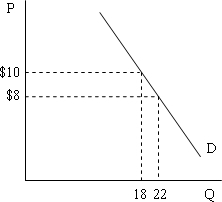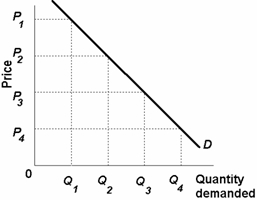 |
| 1 |  | 
Use the following diagram to answer the next question.
 <a onClick="window.open('/olcweb/cgi/pluginpop.cgi?it=jpg::::/sites/dl/free/0077337727/883731/ch04_q1.jpg','popWin', 'width=NaN,height=NaN,resizable,scrollbars');" href="#"><img valign="absmiddle" height="16" width="16" border="0" src="/olcweb/styles/shared/linkicons/image.gif"> (9.0K)</a> <a onClick="window.open('/olcweb/cgi/pluginpop.cgi?it=jpg::::/sites/dl/free/0077337727/883731/ch04_q1.jpg','popWin', 'width=NaN,height=NaN,resizable,scrollbars');" href="#"><img valign="absmiddle" height="16" width="16" border="0" src="/olcweb/styles/shared/linkicons/image.gif"> (9.0K)</a>
Refer to the diagram. Between the prices of $10 and $8, the price elasticity of demand is: |
|  | A) | .5. |
|  | B) | .9. |
|  | C) | 1.11. |
|  | D) | 2. |
|
|
 |
| 2 |  | 
Use the following diagram to answer the next question.
 <a onClick="window.open('/olcweb/cgi/pluginpop.cgi?it=jpg::::/sites/dl/free/0077337727/883731/ch04_q2.jpg','popWin', 'width=NaN,height=NaN,resizable,scrollbars');" href="#"><img valign="absmiddle" height="16" width="16" border="0" src="/olcweb/styles/shared/linkicons/image.gif"> (15.0K)</a> <a onClick="window.open('/olcweb/cgi/pluginpop.cgi?it=jpg::::/sites/dl/free/0077337727/883731/ch04_q2.jpg','popWin', 'width=NaN,height=NaN,resizable,scrollbars');" href="#"><img valign="absmiddle" height="16" width="16" border="0" src="/olcweb/styles/shared/linkicons/image.gif"> (15.0K)</a>
Refer to the diagram. Suppose total revenue at price P3 is the same as at price P2. Then, over the price range from P2 to P3, demand is: |
|  | A) | relatively elastic. |
|  | B) | relatively inelastic. |
|  | C) | unit elastic. |
|  | D) | perfectly elastic. |
|
|
 |
| 3 |  | 
Suppose that a 2% increase in income in the economy decreases the quantity of gadgets demanded by 1% at every possible price. This implies that: |
|  | A) | the supply of gadgets is elastic. |
|  | B) | income elasticity is positive and gadgets are a normal good. |
|  | C) | income elasticity is negative and gadgets are a normal good. |
|  | D) | income elasticity is negative and gadgets are an inferior good. |
|
|
 |
| 4 |  | 
The maker of a particular breakfast cereal found that increasing the price from $4.00 to $4.25 per box had no impact on total revenue, but increasing the price further to $4.50 reduced total revenue by 2%. Thus, the demand for the cereal is: |
|  | A) | inelastic over the range $4.00 to $4.50. |
|  | B) | elastic over the range $4.00 to $4.25 but not over the range $4.25 to $4.50. |
|  | C) | unit elastic over the range $4.00 to $4.25 and elastic over the range $4.25 to $4.50. |
|  | D) | unit elastic over the range $4.00 to $4.25 and inelastic over the range $4.25 to $4.50. |
|
|
 |
| 5 |  | 
A firm finds that its price elasticity of demand is 4.0. Currently, the firm is selling 2000 units per month at $5 per unit. If it wishes to increases its quantity sold by 10%, it must lower its price by: |
|  | A) | $.40. |
|  | B) | $.50. |
|  | C) | 2.5%. |
|  | D) | 4.0%. |
|
|
 |
| 6 |  | 
The cross elasticity of demand between two goods is reported to be +0.2. This implies that: |
|  | A) | a 2% increase in the price of one shifts the demand curve for the other to the left by 1%. |
|  | B) | the two goods are complements. |
|  | C) | the two goods are substitutes. |
|  | D) | both goods are normal goods. |
|
|
 |
| 7 |  | 
Which of the following is likely to have the most elastic demand? |
|  | A) | Food |
|  | B) | Fruit |
|  | C) | Bananas |
|  | D) | Dole brand bananas |
|
|
 |
| 8 |  | 
While it is often relatively easy to shift land from production of one type of grain to another, the process takes a considerable amount of time. This implies that: |
|  | A) | a change in the demand for wheat will not affect its price in the short run. |
|  | B) | the long run supply of oats is more elastic than the long run supply of wheat. |
|  | C) | a change in the demand for corn will change quantity supplied more in the short run than the long run. |
|  | D) | the supply of barley is more elastic in the long run than the short run. |
|
|
 |
| 9 |  | 
Suppose legalization—and subsequent regulation—of heroin and cocaine reduces their prices by 50%. Estimates suggest the total quantity of heroin and cocaine demanded would rise by 83% and 42%, respectively. Consequently, legalization would: |
|  | A) | increase total expenditures on both heroine and cocaine. |
|  | B) | decrease total expenditures on both heroine and cocaine. |
|  | C) | increase total expenditures on heroine and decrease total expenditures on cocaine. |
|  | D) | decrease total expenditures on heroine and increase total expenditures on cocaine. |
|
|
 |
| 10 |  | 
Assume that the price of product Y decreases by 5% and the quantity supplied decreases by 2%. The coefficient of price elasticity of supply for good Y is: |
|  | A) | negative and therefore Y is an inferior good. |
|  | B) | less than one and therefore supply is inelastic. |
|  | C) | more than one and therefore supply is elastic. |
|  | D) | negative and therefore the supply curve is downsloping. |
|
|

